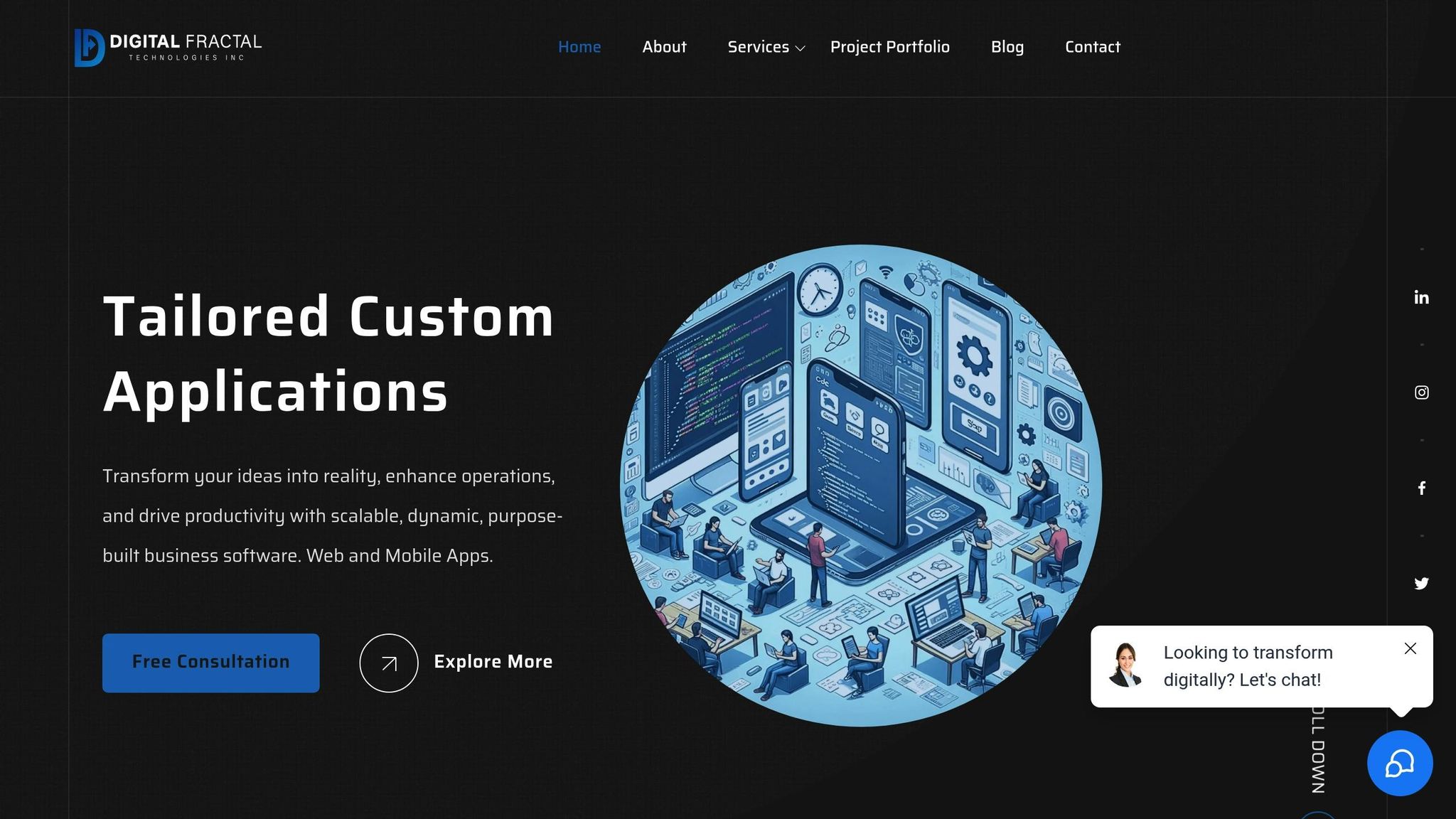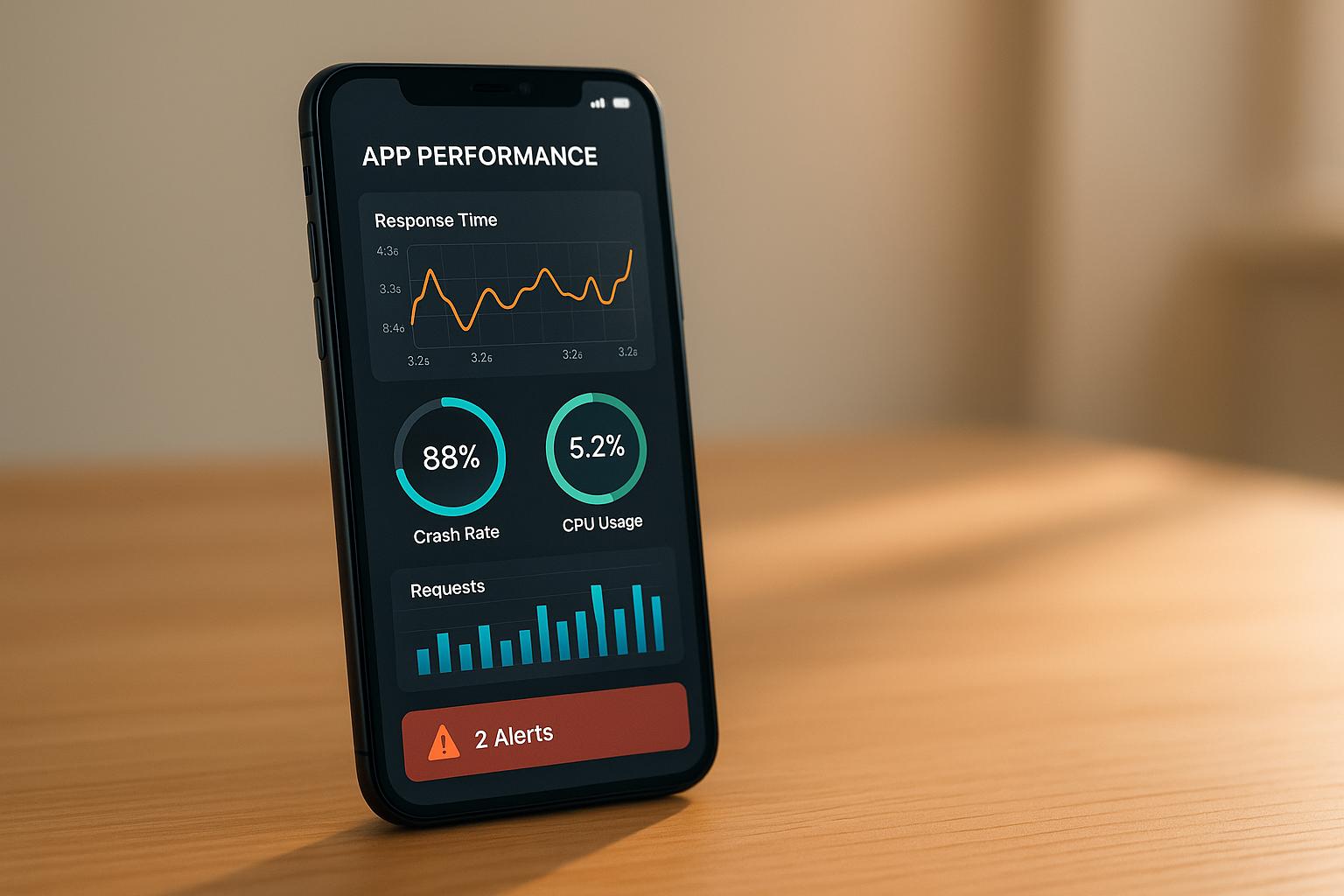
How AI Improves Energy Market Forecasting
AI is transforming energy market forecasting by addressing the growing challenges of integrating renewable energy, managing demand fluctuations, and ensuring grid stability in Canada. Traditional methods struggle with the complexity of modern data and the variability of renewable energy sources. AI steps in with advanced techniques like machine learning, real-time data analysis, and predictive modelling, enabling utilities to make accurate forecasts, reduce waste, and improve grid reliability.
Key Takeaways:
- AI processes real-time data from weather sensors, smart metres, and historical records to predict energy demand and renewable output.
- It minimizes overproduction and underproduction, cutting costs and avoiding grid failures.
- AI tools like predictive maintenance and scenario simulations help maintain grid stability and optimize energy storage.
- Challenges like outdated infrastructure, data quality issues, and skill gaps need to be addressed for effective implementation.
Artificial Intelligence in energy forecasting
AI Techniques and Tools for Energy Market Forecasting
AI-driven energy forecasting relies on advanced machine learning methods to process large datasets, uncover patterns, and make predictions. In Canada, these techniques are transforming how utilities predict energy demand, manage supply fluctuations, and navigate the complexities of market pricing across the country’s varied energy systems.
Main AI Techniques for Forecasting
Several key AI methods – such as supervised and unsupervised learning, reinforcement learning, neural networks, and hybrid models – are at the heart of energy forecasting. These approaches make it possible to interpret historical data, sensor inputs, and changing grid conditions to predict future trends.
Supervised learning is a cornerstone of forecasting. By training models on historical data, it enables accurate predictions of future energy demand. Regression models and time series analysis are common tools here, helping utilities anticipate energy needs based on factors like weather, past consumption, and seasonal patterns. For instance, these models are crucial for forecasting heating demand during Canada’s freezing winters or cooling needs during summer heatwaves.
Unsupervised learning identifies hidden patterns in energy usage without predefined outcomes. Clustering algorithms, for example, can group similar consumption behaviours, allowing utilities to pinpoint customer segments or detect anomalies. This is particularly useful for understanding differences in residential heating habits between regions like British Columbia and Manitoba, where both climate and preferences vary.
Reinforcement learning uses a trial-and-error method to optimize grid management strategies in real time. This dynamic approach is especially beneficial for Canada’s interconnected power systems, where decisions in one province can ripple across others. It helps ensure efficient power flows and resource allocation across the network.
Artificial neural networks excel at analysing complex relationships in energy data. By processing inputs like weather conditions, historical demand, grid performance, and market prices simultaneously, these models generate highly accurate forecasts.
Hybrid models blend AI techniques with statistical methods to balance their individual strengths and weaknesses. A notable example is the Alea methodology, which successfully forecasted changes in the Iberian energy market over a decade, even as the market and generation mix evolved. This approach is also used by financial institutions for assessing risks and financing renewable energy projects.
The effectiveness of these methods grows significantly when paired with real-time data from IoT devices and big data systems.
Combining IoT and Big Data with AI
Integrating IoT devices and big data with AI has shifted energy forecasting from periodic estimates to a continuous, real-time process. Devices like smart metres, grid sensors, and weather stations now generate an immense volume of data that AI systems can analyse for precise predictions.
Smart metres, installed in homes and businesses across Canada, collect detailed consumption data at 15-minute intervals. This granular information allows AI models to detect subtle shifts in demand that traditional monthly billing data might miss. By combining this data with weather inputs from Environment and Climate Change Canada, utilities can accurately predict heating and cooling needs.
Grid sensors play a critical role in monitoring the health of Canada’s extensive power network. These sensors track voltage levels, power flows, and equipment temperatures, feeding data into AI models that predict demand and identify potential constraints. This is essential for managing power flows between provinces and avoiding cascading failures.
Big data analytics processes the massive streams of information generated by these devices. By cleaning and organizing data from thousands of monitoring points, these systems ensure the accuracy and reliability of the information fed into AI models. For example, the Alberta Machine Intelligence Institute (Amii) has developed AI-driven demand forecasting tools that use real-time data to optimize resource allocation, minimize waste, and prevent outages. These tools also support renewable energy integration into provincial grids, aligning with sustainability goals.
AI-Powered Forecasting Tools
Specialized tools built on these AI techniques are streamlining energy forecasting and scenario analysis for the sector.
Cloud-based machine learning platforms like Amazon Web Services (AWS) and Microsoft Azure ML provide the computational power needed to handle massive energy datasets. These platforms offer automated data processing, real-time analytics, and customizable algorithms tailored to regional requirements, reducing the need for utilities to invest in expensive hardware.
Scenario simulation engines are another essential tool. They allow operators to model multiple market scenarios simultaneously, helping them prepare for risks and optimize strategies. For example, these engines can simulate sudden demand spikes during extreme weather or supply disruptions caused by equipment failures. This capability is particularly valuable in Canada’s deregulated energy markets, where price fluctuations can significantly impact utilities and consumers alike.
Industry-specific solutions have also emerged to address unique needs. Nostradamus AI Energy Forecasting Software, for instance, offers cloud-based tools tailored for utilities and energy providers. These tools support scenario simulations, ensure compliance with regulations, and integrate seamlessly with existing energy management systems.
Implementing these tools effectively requires attention to Canadian-specific details, such as metric units, currency formats, and local date conventions. Systems must also comply with provincial energy regulations and privacy standards. To ensure success, utilities should begin with pilot projects to validate AI models before scaling up. Prioritizing data quality and integrating diverse information sources are key steps, along with continuous monitoring and regular updates to adapt to changing market conditions.
AI Applications and Benefits in the Canadian Energy Sector
Canada’s energy sector faces unique challenges, from managing vast power grids across diverse landscapes to integrating renewable energy in extreme weather conditions. AI is stepping in to reshape how energy companies operate, ensuring reliable service for millions of Canadians while improving efficiency across the board.
Improving Grid Stability and Reliability
AI is revolutionizing grid management by making energy demand prediction more accurate. By analysing historical consumption patterns, real-time grid data, and weather forecasts, AI systems can anticipate energy needs across Canada’s varied regions. These advanced forecasting methods have extended prediction windows, improving resource allocation and boosting the value of power generation by as much as 20%.
Real-time optimisation is another game-changer. Utilities can now balance energy production and demand more effectively, cutting operational costs – a benefit that may eventually lead to lower electricity bills for consumers. On top of that, AI-powered predictive maintenance identifies potential equipment failures or grid vulnerabilities before they escalate into outages. By processing continuous data streams from smart meters, sensors, and market reports, AI enables operators to make instant, informed adjustments, keeping the grid stable and responsive.
Managing Renewable Energy Sources
Integrating renewable energy into the grid comes with its own set of hurdles, but AI is proving to be a valuable ally. Wind and solar energy, while sustainable, can be unpredictable. AI addresses this by using weather forecasts, historical energy data, and sensor inputs to enhance the accuracy of renewable energy output predictions. In a country as geographically and climatically diverse as Canada, this capability is crucial. For example, AI can analyse data from Environment and Climate Change Canada alongside local weather station inputs to forecast solar and wind generation patterns specific to regions – whether it’s the winds of Nova Scotia or the sunshine of Saskatchewan.
By factoring in variables like cloud cover or temperature changes, AI continuously refines its predictions. This means grid operators can better coordinate renewable energy inputs, ensuring that fluctuations in output don’t disrupt grid stability. In essence, AI helps make renewable energy a more reliable part of the energy mix.
Optimising Energy Storage and Market Trading
Energy storage is becoming smarter with AI. Systems now analyse demand forecasts, renewable energy predictions, and market prices to determine the best times to charge or discharge batteries. This predictive approach allows for more efficient use of stored energy and helps operators align storage activities with market conditions.
In deregulated markets like Alberta, AI also plays a critical role in energy trading. By processing historical trading data, weather forecasts, and grid conditions, AI identifies the best opportunities for buying and selling energy. These insights help energy companies navigate the complexities of the market while tailoring solutions to the specific needs of the Canadian energy landscape.
sbb-itb-fd1fcab
Overcoming AI Implementation Challenges
While AI holds immense promise for energy forecasting, the journey to implementation is far from straightforward. Canadian energy companies face several hurdles that can make or break their AI initiatives. Tackling these challenges with a clear plan is essential to avoid costly missteps and achieve meaningful results.
Technical and Operational Barriers
One of the biggest hurdles is integrating AI with outdated infrastructure. Many utilities in Canada still rely on systems built decades ago, which were never designed to handle the demands of modern AI technology. These legacy systems often lack the interfaces needed for real-time data sharing or rely on outdated formats, making it difficult to feed accurate and timely data into forecasting models. Without access to current grid or weather data, the reliability of AI predictions suffers.
Another issue is the quality of the data itself. Legacy systems frequently produce inconsistent or incompatible data, creating additional barriers to seamless integration with AI platforms. Poor data quality not only decreases the accuracy of forecasts but also erodes confidence in the system, leaving operators reluctant to rely on it when critical decisions are on the line.
AI’s complexity poses yet another challenge. Advanced machine learning models demand highly specialized expertise, which is in short supply within the Canadian energy sector. This skills gap can slow down implementation, inflate costs, and leave teams unprepared to troubleshoot problems or fine-tune systems as needed. Together, these technical challenges can delay projects, lower forecast precision, and reduce the system’s ability to adapt to market fluctuations – ultimately affecting operational efficiency and grid stability.
Best Practices for AI Adoption
To navigate these challenges, companies need a strategic approach. Start by gaining executive support and involving teams from across the organization early on. AI implementation isn’t just an IT concern; it requires collaboration between operations, data science, and leadership to ensure resources and alignment.
Focus on targeted use cases rather than trying to solve every problem at once. For example, concentrating on short-term load forecasting can deliver quick wins, building momentum and trust in AI systems.
Scalability is another critical factor. Opt for cloud-based or modular solutions that can grow with your organization. These systems allow for easier expansion as new data sources or algorithms become available, supporting both pilot projects and long-term goals.
Compliance with regulations is also key. Canadian energy companies must adhere to laws like the Personal Information Protection and Electronic Documents Act (PIPEDA) and other industry-specific rules. Keeping transparent records of data sources, model methods, and decision-making processes not only simplifies regulatory audits but also fosters trust among stakeholders.
Investing in training programs is essential to bridge the skills gap. By equipping teams with the knowledge they need, companies can better manage the complexities of AI. Encouraging collaboration between data scientists and energy market experts helps ensure that AI solutions are both technically sound and operationally relevant.
Finally, implement continuous monitoring and feedback loops to keep AI models accurate as conditions evolve. Regular updates and validations help maintain their effectiveness, ensuring that forecasting systems remain reliable over time.
Successful AI Implementation Examples
Global energy firms have shown that phased approaches to AI deployment can lead to success. Starting with pilot projects allows companies to demonstrate value early on, building confidence before scaling up.
Key elements of successful implementations include seamless data integration, strong teamwork between IT and operations, and a commitment to ongoing model refinement. For instance, some utilities have used AI to predict electricity demand surges during extreme weather events by combining real-time data from smart metres with weather data from Environment and Climate Change Canada.
Collaborating with experienced AI consultants can also make a significant difference. Companies like Digital Fractal Technologies Inc specialize in creating AI solutions tailored to the Canadian energy market. Their expertise helps organizations address local data and regulatory challenges, ensuring a smoother and more effective implementation.
Explainable AI techniques are another cornerstone of success. When grid operators understand how AI systems arrive at their recommendations, they are more likely to trust and act on them, maximizing the return on investment and reinforcing the system’s value.
Digital Fractal Technologies Inc‘s Role in AI-Powered Energy Forecasting

As Canadian energy companies face the challenges of adopting AI, having the right expertise becomes crucial. Digital Fractal Technologies Inc steps in with its proficiency in custom software development and AI consulting, offering tailored solutions to help energy organizations navigate these hurdles. Their approach builds on earlier discussions about how AI can address forecasting challenges, supporting the shift from traditional methods to AI-driven forecasting.
Digital Fractal Technologies Inc tackles integration challenges with its specialized, cutting-edge tools designed to meet the unique needs of the energy sector.
Custom AI Solutions for Energy Forecasting
Digital Fractal Technologies Inc creates AI tools that work seamlessly with existing infrastructure, providing precise predictions for energy demand, risk management, and grid optimization. Using advanced AI techniques, their systems analyse complex consumption and generation patterns by leveraging both historical and real-time data from sources like weather stations, smart metres, and grid sensors. They also use a hybrid approach, combining statistical and econometric models with AI, making forecasts more transparent and easier for grid operators to trust.
Workflow Automation and Predictive Analytics Integration
In addition to improving forecasting accuracy, the company enhances operational efficiency by integrating predictive analytics and automating workflows. These systems streamline maintenance scheduling and reduce downtime by identifying potential equipment failures and grid vulnerabilities before they happen. This proactive approach extends the lifespan of critical infrastructure and improves overall reliability.
Tailored Solutions for Canadian Energy Market Needs
Digital Fractal Technologies Inc ensures its solutions align with Canadian regulatory standards and market conditions. Their AI systems factor in Canada’s unique climate patterns, energy usage trends, and evolving policies, delivering accurate forecasts while meeting compliance requirements. They also help integrate renewable energy sources by predicting variable outputs from wind and solar installations – an essential feature as Canada moves toward cleaner energy.
By analysing localized weather data, historical generation records, and real-time inputs from sensors, their AI models provide reliable forecasts for renewable energy output. This capability supports grid operators in managing the variability that comes with renewable energy. Additionally, all interfaces are designed to meet Canadian standards and conventions.
Digital Fractal’s scalable applications are built to adapt to the changing needs of clients, ensuring long-term value in Canada’s dynamic energy market. Their consulting services further assist energy organizations in evaluating their digital readiness and identifying opportunities for AI-driven advancements. This comprehensive approach provides a clear roadmap for addressing immediate challenges while preparing for future growth.
The Future of AI in Energy Market Forecasting
The energy sector is undergoing a significant transformation, with AI taking centre stage in reshaping how energy forecasting is approached. By predicting, managing, and optimizing operations in ways traditional methods simply cannot, AI has gone from being a cutting-edge innovation to a must-have tool in modern energy management. For Canada, where sustainability and grid reliability are top priorities, this evolution is especially critical.
AI is revolutionizing energy forecasting by seamlessly integrating renewable energy sources, stabilizing power grids, and improving resource allocation. This is changing how energy companies make decisions and plan their operations, offering a level of precision and adaptability that older methods cannot match.
Main Benefits of AI in Energy Forecasting
AI brings a host of advantages to energy forecasting, addressing longstanding challenges in the sector. One of its key strengths lies in advanced pattern recognition, which allows for continuously improving accuracy as conditions change over time. With its ability to adapt dynamically through constant data input, AI ensures predictions stay up to date.
For example, AI can forecast energy needs up to 36 hours ahead, boosting power generation value by 20% while minimizing outages through predictive maintenance. This level of foresight helps utilities manage energy production in real time, striking a balance between supply and demand. The result? Lower operational costs by reducing overproduction and unnecessary energy storage.
Another major benefit is environmental impact. By enabling more efficient energy management, AI supports carbon reduction goals and facilitates the use of renewable energy sources like solar and wind. Its ability to accurately predict variable outputs and manage the complexities of distributed energy generation makes it easier to integrate renewables into the grid.
These compelling benefits highlight why energy companies must prioritize adopting AI-driven forecasting solutions.
Why Energy Companies Should Adopt AI Solutions
With the clear operational and financial advantages, embracing AI is no longer optional – it’s a necessity. Traditional forecasting methods often fall short in today’s fast-changing energy landscape. They struggle to account for dynamic factors like shifting weather patterns, sudden spikes in demand, and evolving consumption trends.
Many utility companies are already leveraging AI-based tools to make real-time decisions and manage smart grids more effectively. Those that delay adoption risk being outpaced by competitors who can optimize their operations, reduce waste, and enhance customer satisfaction through AI insights.
AI also excels in handling the complexities of modern energy systems. It simplifies the integration of renewable sources, distributed generation, and smart grid technologies – areas where traditional approaches often falter. For instance, AI can detect hidden patterns, such as the impact of cloud cover on solar energy production or sudden increases in home electricity use. These insights enable utilities to fine-tune their forecasts and respond proactively.
To fully realize AI’s potential, companies need tailored solutions that align with their specific needs and regulatory requirements. Expert guidance is essential to ensure successful implementation and maximum return on investment. Solutions must also be scalable, adapting to Canada’s diverse climate and renewable energy resources.
The evidence is undeniable: AI-powered forecasting is improving accuracy, efficiency, and sustainability. As AI and machine learning continue to advance, they will drive the creation of even more reliable tools. Companies that embrace these technologies now will be well positioned to thrive in a rapidly evolving energy market.
FAQs
How does AI help integrate renewable energy sources into Canada’s power grid?
AI is transforming how renewable energy sources like wind and solar are integrated into Canada’s power grid. By processing massive amounts of real-time and historical data, AI can fine-tune energy demand forecasts, provide more precise predictions of renewable energy output, and streamline grid operations to maintain a steady balance between supply and demand.
Additionally, AI is a key player in advancing smarter grids. It enables dynamic load management and helps pinpoint inefficiencies or potential failures within the system. These improvements contribute to a more reliable energy network, easing the transition to renewable energy while boosting efficiency across Canada.
What challenges do Canadian energy companies face when adopting AI, and how can they address them?
Canadian energy companies face several hurdles when trying to adopt AI technologies. These include steep implementation costs, complexities in managing data, and a shortage of skilled professionals. Such challenges often slow the pace of adoption and make it harder to fully realize AI’s potential in the energy sector.
One way to tackle these issues is by starting small. Companies can focus on manageable, scalable AI projects that clearly demonstrate value before committing to larger initiatives. Another key step is investing in workforce training to bridge the skill gap. Collaborating with experts in AI consulting – such as the team at Digital Fractal Technologies Inc. – can also make the process smoother. With tailored solutions and expert guidance, businesses can ensure their AI strategies align with their specific needs, ultimately boosting efficiency and enhancing decision-making across the energy market.
How do AI-powered tools help reduce electricity costs and improve grid reliability in Canada?
AI-powered tools are transforming Canada’s energy systems, making them more efficient and reliable. By delivering precise forecasts for energy demand and supply, these technologies help optimize energy distribution. This means less waste and lower costs for consumers. They also enable proactive grid management, allowing potential issues to be identified early and ensuring quicker responses to outages or disruptions.
Companies like Digital Fractal Technologies Inc. are leveraging AI-driven solutions and workflow automation to refine energy forecasting. These advancements contribute to improved grid stability and smoother operations across the energy sector.

